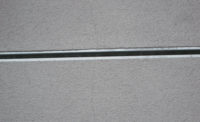Three Challenging Stucco Trends to Overcome

A commercial project that used high-end products, a building envelope consultant and an experienced plaster crew. Yet, the top of the stucco assembly is a reverse lap. The building paper is over the flange of the parapet flashing.

The floating process of the brown prepares the base for the eventual finish coat; it is too often forgotten. The process also densifies and consolidates the brown coat. This makes it more resistant to cracks and water penetration. The float must be a hard material.












Cement stucco has been around longer than the building codes. Whether it is applied over masonry or framed walls, cement stucco can provides a strong, water-resistant cladding that
can outlast others, provide fire protection, requires little to no maintenance, and takes a beating. Cold weather has little impact on cement stucco. Germany and Switzerland prove that stucco works in those climates. Saudi Arabia and Israel prove it works there, as well.
Yet, cement stucco is under attack. While some believe stucco is not suitable for rain or humidity, it has been proven to work in Seattle and Miami. So, what makes it work and what makes it not?
The list of things that designers, contractors and inspectors miss or ignore are long. After 40 years in the stucco industry, I see three trends that are disturbing. And if the industry does not reverse those trends, stucco will be in jeopardy of losing major market share in cladding. There are certainly more than three issues but these trends are the most attention grabbing.
Reverse Laps
It is unbelievable that they still occur. The shingles on your roof are installed to shed water down. The vents that penetrate the roof covering have a flashing ring. The upper layer always overlaps the lower layer. It is not hard to really understand that water flows downhill. I am well aware of design pressures and how water is drawn upwards but the simple fact is that we see reverse laps all the time. The television reporter who covers consumer news shows a piece of stucco being removed to illustrate the wood rot. There is no denying it is rotted. Yet, what almost all fail to see is the reverse lap that is so often clearly visible.
Why is this so hard to fix? Well, there is no money to be made in fixing the reverse lap issue. While it would almost eliminate the water intrusion issue, without profit agenda, it’s not going to happen.
I have seen reverse laps with building envelope consultants on the project. They can happen due to just a moment of confusion or the worker doing what they were taught to do.
The Go-Devil
This tool is known by many names: the slicker, the shalle and cheater. They’re all the same. A large tool used to apply larger amounts of plaster to a wall in a faster time. The problem is that this big tool requires a lot of strength and plasterers are human. They quickly learn to not push so hard to save their strength. They essentially end up “laying” the plaster on the lath and not fully embedding it. The back of the lath is exposed and if water gets in, it will rust. In severe cases, it will decay fastener connections and fall off the wall. Even the Go-Devil can be a trend we could possibly live with by crossing our fingers. But item three seals the deal for failure.
Sponge Floating
In the 1950s, plasterers used wood or cork floats on the brown coat and they had to wait until sufficient mix water dissipated to float the brown coat. The act of hard floating consolidated the cement, making it more resistant to cracking and water intrusion.
Today, the green sponge float is preferred. It is faster and easier. You don’t have to wait and it’s a light easy touch. The surface looks great and ready for a finish coat. Unfortunately, it is not densified and is subject to shrinkage cracking and water intrusion through the stucco.
Conclusion
Cement stucco has been around longer than the building codes. Whether it is applied over masonry or framed walls, cement stucco can provide a strong water-resistant cladding that can outlast others, provide fire protection, requires little to no maintenance, and takes a beating. Cold weather has little impact on cement stucco. Germany and Switzerland prove that stucco works in those climates. Saudi Arabia and Israel prove it works there, as well.
Yet, cement stucco is under attack. While some believe stucco is not suitable for rain or humidity, it has been proven to work in Seattle and Miami. So, what makes it work and what makes it not?
Looking for a reprint of this article?
From high-res PDFs to custom plaques, order your copy today!

















